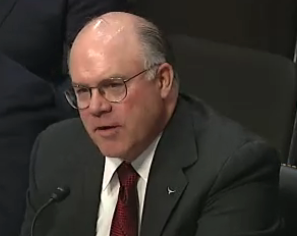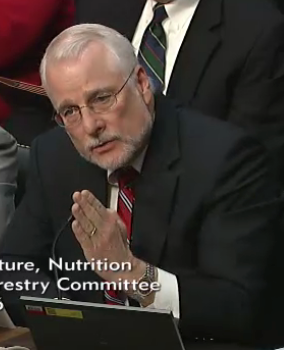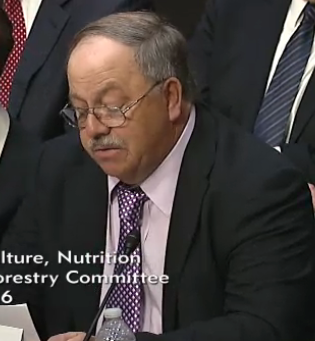NRCS, FSA propose streamlining and reform as lawmakers debate funding for conservation-title programs like EQIP and CRP.
|
|
Growing up in northern Montana during the 1960s, no-tiller Carol Mattson remembers days when his school bus would be sent home early due to blowing dust in the area.
As his bus bounced along a dirt road, the driver would occasionally have to stop and wait for dust to clear so he could see well enough to continue.
“Dust would sift through the loose-fitting slide-up windows, eventually settling on the seats thick enough for us to draw the boxes and play tic-tac-toe,” Mattson says.
But on Tuesday during a hearing on the 2012 Farm Bill, the Chester, Mont., no-tiller told Washington lawmakers that conservation programs played a major role in the success of his family’s dryland wheat operation.
“When we made the transition to no-till in the early 1990s, we didn’t realize we were sequestering carbon at the same time — no one did,” he told the U.S. Senate Committee on Agriculture, Nutrition and Forestry. “Each conservation practice we adopt opens doors to additional possibilities.
“Adopting conservation practices, and doing the right thing for the environment, helped our farm prosper.”
Future Of Conservation
Hearings are continuing in Washington this spring on the authorization for the 2012 Farm Bill that governs ag policies, including subsidies and conservation and nutrition programs.
The conservation title to the Farm Bill includes programs such as Environmental Quality Incentives Program (EQIP), the Conservation Stewardship Program (CSP) and Conservation Reserve Program (CRP).
With a presidential election in play this year, and record-high commodity and farmland prices lingering into 2012, many lawmakers are feeling the pressure to reduce spending on some ag-related programs.
|
|
Last fall, a hastily written version of the Farm Bill was considered by the failed Joint Select Committee on Deficit Reduction, a group of 12 U.S. lawmakers charged with finding $1 trillion to cut from federal budgets.
At the time, Senate Ag Committee Chairwoman Debbie Stabenow (D-Mich.) and House Ag Committee Chairman Frank Lucas (R-Okla.), both minority leaders, helped write recommendations that could cut some $23 billion in cuts to the Farm Bill conservation title over 10 years, possibly including $6 billion in cuts in conservation programs. Now the U.S. House and Senate are beginning the regular process of holding hearings and drafting the bill.
President Obama’s proposed budget for 2012-13 proposes capping CRP at 30 million acres, down from the 2008 Farm Bill cap of 32 million acres. The cap would be attained by natural attrition through expiring contracts and by setting future enrollments at slightly lower levels. The action would save an estimated $977 million over 10 years.
Supporters of conservation programs said Tuesday they’re worried these cuts could go even deeper, especially when the U.S. House begins debate on the Farm Bill later this year. A House Budget Committee proposal last year pegged $33 billion to be cut from the Farm Bill over a decade.
The 2008 bill expires on Sept. 30. Ranking U.S. Senate minority member Pat Roberts (R-Kan.) has called for the new package to be finished by Memorial Day, but many observers think that deadline is too optimistic.
Earl Garber, president-elect of the National Assn. of Conservation Districts, says Farm Bill programs are helping many producers stay in compliance with environmental regulations at a time where they’re already asked to do more with less.
“We must acknowledge the investment of putting conservation staff on the ground. Technical assistance critical in ensuring programs implemented with accountability,” Garber says. “Any cuts above the $23 billion submitted by the Joint Select Committee will put the viability of these programs at risk.”
NRCS, FSA Programs Growing
In recent years, NRCS Chief Dave White says, the NRCS has seen steady growth in several of its programs. After the last Farm Bill was authorized in 2008, the NRCS enrolled more than 127 million acres of land in 12 Farm Bill conservation programs between 2009 and 2011 — an area nearly twice the size of Wyoming.
EQIP helped farmers and ranchers implement conservation measures on over 38 million acres, and CSP is now among the largest USDA conservation programs with another 38 million acres enrolled, White says. The agency has also obligated more than $6 billion in financial assistance in nearly 214,000 contracts with farmers and ranchers.
White says the next Farm Bill should continue funding a strong conservation title that streamlines conservation programs and increases flexibility to address the most pressing conservation needs of agriculture.
The bill should also emphasize projects that address regional priorities and leverage resources, “so that the public conservation investment goes further,” he says.
CRP provides cost-share assistance, annual rental payments and sometimes additional incentives to farmers and ranchers to establish long-term contracts for conservation cover on eligible farmland.
Rental payments, which total about $1.7 billion annually, are based on the agricultural rental value of the specific parcels of land accepted into the program.
The Farm Service Agency (FSA) is responsible for compliance determinations, consultations with other federal agencies, such as the U.S. Fish and Wildlife Service, and determining the environmental benefits index (EBI) for general signup CRP.
FSA Administrator Bruce Nelson says CRP, first authorized by the 1985 Farm Bill, has taken on higher importance after last year’s dust storms plagued farmers. But there’s lingering concern about what will happen when contracts for 6.5 million acres of CRP expire at the end of fiscal year 2012.
CRP currently contains nearly 30 million acres of grasses, trees, riparian buffers, filter strips, restored wetlands and high-value wildlife habitat. This number is down from 36.8 million acres at the end of FY 2007. But enrollment in non-competitive “continuous signup” CRP has grown from 3.7 million acres in 2007 to 5.3 million acres in 2012.
The continuous-signup program addresses high-priority environmental concerns and tend to be relatively small in size, involving buffer, wetland-related, and wildlife-directed practices. Land is targeted to achieve specific environmental concerns, such as reducing agricultural runoff and improving wildlife habitat.
“Since the program began in 1985, more than 8 billion tons of soil have been prevented from eroding,” Nelson says. “In 2011, nitrogen and phosphorus releases from enrolled acres were reduced by an estimated 623 million pounds and 124 million pounds, respectively.
“We believe the program can become even more focused on marginal and environmentally sensitive lands. This will ensure that CRP provides the greatest public benefit to the American taxpayer,” Nelson says.
No-Till Shaves Input Costs
On Mattson’s farm, just south of the Canadian border, water limits wheat production. His farm was transitioned to no-till to conserve moisture and protect the soil from wind and water erosion.
“We aggressively pursued the adoption of no-till farming and precision technology,” Mattson says. “Pioneering these practices in our state placed us in a position to be awarded the Montana’s first Conservation Security Program contract.”
Mattson says no-till provided an immediate 33% per-acre reduction in diesel fuel used over the previous year, a cost savings that has been realized annually for the past 19 years.
Mattson used to calculate at least a 4% overlap cost in his operation, but adding auto-steer technology nearly eliminated that in his planting, fertilizing and spraying activities.
He’s also seen improvements in long-term soil health, with increased soil organic matter and better water-holding capacity.
“More water directly translates to more wheat,” Mattson says. “And in the absence of tillage earthworms now populate our fields. Their tunnels further aid the percolation of water deeper into the soil profile.
“The layer of residual plant material allowed to lie on the soil surface reduces evaporation. Water and soil erosion are all but eliminated, preserving the valuable nutrients residing in the precious top soil.”
Mattson says his son, now 33, hasn’t experienced dust events that he witnessed as a child. But he believes lawmakers and the farming industry are standing at an important crossroads for U.S. ag policy, especially for conservation programs.
By 2050, he notes, the world will have to increase food production by as much as 70% to 80% to feed a burgeoning world population.
“Just maintaining our current levels of conservation practices, frankly, may not be enough to meet the unprecedented requirements of feeding 9 billion people,” he says. “Vigilance is needed to ensure that we don’t create perverse incentives that lead to unintended consequences and present moral hazards.
“We must create an atmosphere where innovators are encouraged to innovate. Top-down government regulation, such as the Endangered Species Act, discourages innovation, and limits our producers’ ability to keep working lands working.”
|
Hoisington, Kan., farmer Dean Stoskopf says the NRCS needs to make sure programs are simple and locally focused, which will increase their effectiveness and also allow the agency to cut overhead costs. |
Dean Stoskopf, who has a 125-head Red Angus cow-calf herd and grows wheat, grain sorghum, alfalfa and forages near Hoisington, Kan., says the NRCS needs to keep programs simple and locally focused, rather than making field agents regulators of environmental laws.
“Currently there are too many programs with similar objectives,” he says. “I’m concerned the Conservation Stewardship Program doesn't offer the same level of benefits for our investment.
“Although it’s intended to be a comprehensive approach to conservation with payments made for implementing specific practices, I see compliance issues that lead to mistrust and dollars being spent without the same level of benefit of other programs.
“And reducing the complexity of these programs should also reduce overhead and allow dollars to reach their intended purposes.”

 No-tiller Carol Mattson tells the U.S. Senate Ag Committee that no-till cut diesel use by 33% and reduced overlap costs by 4% on his dryland wheat operation near Chester, Mont. Soil organic matter improved and water and soil erosion were brought under control, he adds.
No-tiller Carol Mattson tells the U.S. Senate Ag Committee that no-till cut diesel use by 33% and reduced overlap costs by 4% on his dryland wheat operation near Chester, Mont. Soil organic matter improved and water and soil erosion were brought under control, he adds. NRCS Chief Dave White says his agency enrolled more than 127 million acres of land in 12 Farm Bill conservation programs between 2009 and 2011 — an area nearly twice the size of Wyoming.
NRCS Chief Dave White says his agency enrolled more than 127 million acres of land in 12 Farm Bill conservation programs between 2009 and 2011 — an area nearly twice the size of Wyoming.






Post a comment
Report Abusive Comment